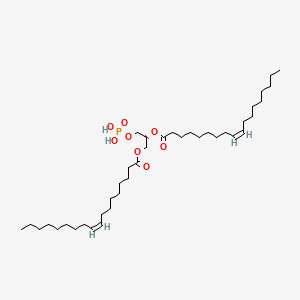| Authors | Title | Published | Journal | PubMed Link |
|---|---|---|---|---|
| Raines DE and Krishnan NS | Agonist binding and affinity state transitions in reconstituted nicotinic acetylcholine receptors revealed by single and sequential mixing stopped-flow fluorescence spectroscopies. | 1998 | Biochim. Biophys. Acta | pmid:9814855 |
| Dalton KA et al. | Anionic lipids and accumulation of Ca2+ by a Ca(2+)-ATPase. | 1998 | Biochem. Soc. Trans. | pmid:9765953 |
| Hixon MS et al. | Calcium-dependent and -independent interfacial binding and catalysis of cytosolic group IV phospholipase A2. | 1998 | Biochemistry | pmid:9622504 |
| Oja CD et al. | Influence of dose on liposome clearance: critical role of blood proteins. | 1996 | Biochim. Biophys. Acta | pmid:8652601 |
| Farren SB et al. | Polymorphic phase preferences of phosphatidic acid: A 31P and 2H NMR study. | 1983 | Biochem. Biophys. Res. Commun. | pmid:6838577 |
| Miner VW and Prestegard JH | Structure of divalent cation-phosphatidic acid complexes as determined by 31P-NMR. | 1984 | Biochim. Biophys. Acta | pmid:6743656 |
| Brasseur R et al. | Mode of organization of lipid aggregates: a conformational analysis. | 1984 | Biosci. Rep. | pmid:6547066 |
| Nayar R et al. | Phosphatidic acid as a calcium ionophore in large unilamellar vesicle systems. | 1984 | Biochim. Biophys. Acta | pmid:6435674 |
| Smaal EB et al. | Essential adaptation of the calcium influx assay into liposomes with entrapped arsenazo III for studies on the possible calcium translocating properties of acidic phospholipids. | 1985 | Biochim. Biophys. Acta | pmid:3924100 |
| Smaal EB et al. | 2H-NMR, 31P-NMR and DSC characterization of a novel lipid organization in calcium-dioleoylphosphatidate membranes. Implications for the mechanism of the phosphatidate calcium transmembrane shuttle. | 1987 | Biochim. Biophys. Acta | pmid:3814595 |
| Nicolay K et al. | Ethylene glycol causes acyl chain disordering in liquid-crystalline, unsaturated phospholipid model membranes, as measured by 2H NMR. | 1986 | FEBS Lett. | pmid:3803574 |
| Houslay MD et al. | Acidic phospholipid species inhibit adenylate cyclase activity in rat liver plasma membranes. | 1986 | Biochem. J. | pmid:3741383 |
| Smaal EB et al. | Consequences of the interaction of calcium with dioleoylphosphatidate-containing model membranes: changes in membrane permeability. | 1986 | Biochim. Biophys. Acta | pmid:3730389 |
| Woźniak M et al. | The influence of phosphatidate bilayers on pig heart AMP deaminase. Crucial role of pH-dependent lipid-phase transition. | 1988 | Biochem. J. | pmid:3214434 |
| Smaal EB et al. | Consequences of the interaction of calcium with dioleoylphosphatidate-containing model membranes: calcium-membrane and membrane-membrane interactions. | 1987 | Biochim. Biophys. Acta | pmid:3099843 |
| Mizuno S et al. | Dioleoyl-phosphatidic acid selectively binds to α-synuclein and strongly induces its aggregation. | 2017 | FEBS Lett. | pmid:28186641 |
| Rivero Berti I et al. | Delivery of fluorophores by calcium phosphate-coated nanoliposomes and interaction with Staphylococcus aureus biofilms. | 2016 | Colloids Surf B Biointerfaces | pmid:26954088 |
| Chen YF et al. | Differential dependencies on [Ca2+] and temperature of the monolayer spontaneous curvatures of DOPE, DOPA and cardiolipin: effects of modulating the strength of the inter-headgroup repulsion. | 2015 | Soft Matter | pmid:25907686 |
| Li J et al. | Calcium phosphate nanoparticles with an asymmetric lipid bilayer coating for siRNA delivery to the tumor. | 2012 | J Control Release | pmid:22056915 |
| Lebeau L et al. | Two-dimensional crystallization of DNA gyrase B subunit on specifically designed lipid monolayers. | 1990 | FEBS Lett. | pmid:2163898 |
PA(18:1(9Z)/18:1(9Z))
PA(18:1(9Z)/18:1(9Z)) is a lipid of Glycerophospholipids (GP) class. The involved functions are known as adenylate cyclase activity, inhibitors, Drug Interactions, Membrane Fluidity and Force. Pa(18:1(9z)/18:1(9z)) often locates in Cell membrane, Tissue membrane, Epidermis, Connective Tissue and Back. The associated genes with PA(18:1(9Z)/18:1(9Z)) are growth promoting activity and RAF1 gene. The related lipids are Phosphatidic Acid, Lysophospholipids, lysophosphatidic acid, Lysophosphatidylcholines and dioleoyl phosphate.
Cross Reference
Introduction
To understand associated biological information of PA(18:1(9Z)/18:1(9Z)), we collected biological information of abnormalities, associated pathways, cellular/molecular locations, biological functions, related genes/proteins, lipids and common seen animal/experimental models with organized paragraphs from literatures.
What diseases are associated with PA(18:1(9Z)/18:1(9Z))?
There are no associated biomedical information in the current reference collection.
No disease MeSH terms mapped to the current reference collection.
PubChem Associated disorders and diseases
What pathways are associated with PA(18:1(9Z)/18:1(9Z))
There are no associated biomedical information in the current reference collection.
PubChem Biomolecular Interactions and Pathways
Link to PubChem Biomolecular Interactions and PathwaysWhat cellular locations are associated with PA(18:1(9Z)/18:1(9Z))?
Visualization in cellular structure
Associated locations are in red color. Not associated locations are in black.
Related references are published most in these journals:
| Location | Cross reference | Weighted score | Related literatures |
|---|
What functions are associated with PA(18:1(9Z)/18:1(9Z))?
Related references are published most in these journals:
| Function | Cross reference | Weighted score | Related literatures |
|---|
What lipids are associated with PA(18:1(9Z)/18:1(9Z))?
Related references are published most in these journals:
| Lipid concept | Cross reference | Weighted score | Related literatures |
|---|
What genes are associated with PA(18:1(9Z)/18:1(9Z))?
Related references are published most in these journals:
| Gene | Cross reference | Weighted score | Related literatures |
|---|
What common seen animal models are associated with PA(18:1(9Z)/18:1(9Z))?
There are no associated biomedical information in the current reference collection.
